Understanding Lab-Created vs Natural Diamonds
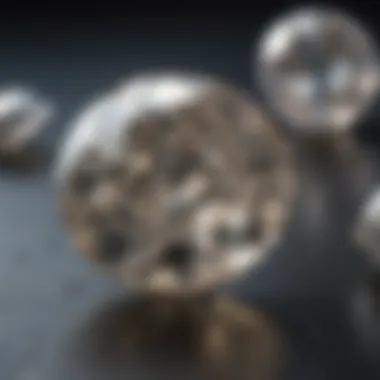
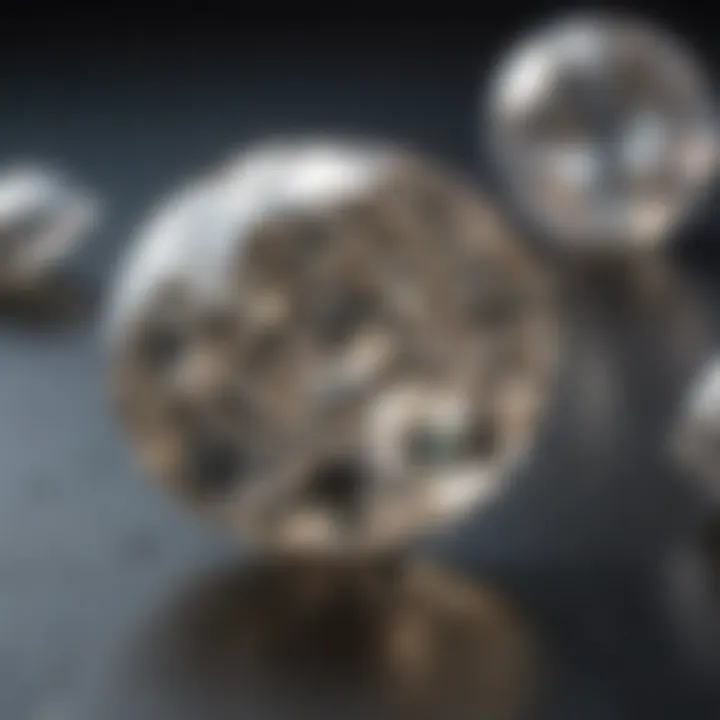
Intro
The world of gemstones is one filled with fascination and allure, particularly when it comes to the diamond. Among enthusiasts and collectors, there exists a spirited debate about the merits and distinctions of lab-created diamonds versus their natural counterparts. These two types of diamonds often find themselves placed side by side in the display cases of jewelers, each with its own narrative and unique characteristics. In this discussion, we will peel back the layers to reveal the fundamental aspects that differentiate these gems, focusing on their formation, properties, and the ethical considerations that might influence purchasing decisions.
Gemstone Overview
Definition and characteristics
Diamonds, the quintessential symbol of love and enduring beauty, come in two primary types: natural and lab-created. Natural diamonds are formed over billions of years under intense heat and pressure deep within the Earth's mantle. These geological processes result in the formation of this durable crystalline structure, which has captivated humanity for centuries.
Conversely, lab-created diamonds are cultivated in controlled environments using advanced technology. These gems, often referred to as synthetic diamonds, display identical physical and chemical properties to their natural cousins. They can take just a few weeks to form, contrasting sharply with the ages needed for natural in the rugged depths of the Earth.
Classification of gemstones
Gemstones can be broadly classified based on their origin, composition, and the processes through which they are formed. The classification usually falls into two categories:
- Natural gemstones: These are created by natural geological processes.
- Synthetic gemstones: Created in laboratories, mimicking the natural processes of formation.
Both categories have subgroups, but in the case of diamonds, the primary classification centers around natural and lab-created. Understanding this classification is paramount for collectors and enthusiasts as it shapes market values and perceptions.
Properties of Gemstones
Physical properties
Both lab-created and natural diamonds share a multitude of physical properties that include hardness, brilliance, and thermal conductivity. The most iconic feature of diamonds, their hardness, ranks at a staggering 10 on the Mohs scale, making them the hardest known natural material. This hardness is a defining factor in their desirability and practicality as gemstones.
Additionally, both types exhibit astounding brilliance and fire due to their high refractive index, contributing to their mesmerizing appearance. The cuts of diamonds, whether natural or lab-grown, play an influential role in how light interacts with each stone, ultimately affecting their sparkle and visual appeal.
Chemical properties
From a chemical standpoint, both types of diamonds are composed of carbon crystals arranged in a tetrahedral structure. This uniform arrangement is what classifies them both fundamentally as diamonds regardless of their origin. The primary difference lies in trace elements within the stones—natural diamonds often contain inclusions or impurities that provide unique identifying features.
Lab-created diamonds usually feature fewer inclusions and may offer options that are entirely flawless. This purity can enhance their appeal but can also raise questions about authenticity and artistry in the gemstone industry.
"Understanding the fundamental differences between lab-created and natural diamonds is essential for making informed choices in a market abundant with options."
Completing this comprehensive analysis requires a deeper dive into the ethical implications surrounding both types of diamonds, reflecting on sourcing, environmental impact, and value perception. As we venture deeper into this conversation, critical insights emerge that can equip enthusiasts and collectors with the information necessary to navigate their diamond purchases effectively.
Prelims
In today's gemstone market, understanding the distinctions between lab-created diamonds and natural diamonds is paramount for both enthusiasts and collectors. With the increasing presence of lab-created options, it becomes essential to comprehend the implications of these differences on value, ethics, and personal choice. In an age where consciousness regarding sustainable and ethical sourcing is growing, consumers find themselves navigating the murky waters of diamond purchases. This article serves as a guide to untangle these complexities, empowering readers to make informed decisions.
Defining Lab-Created and Natural Diamonds
Lab-created diamonds, as the name implies, are produced in controlled environments using advanced technology that mimics the conditions found in nature. These diamonds boast identical physical and chemical properties to their natural counterparts, which have taken millions of years to form deep within the Earth’s crust. Understanding these terms is the first step in the journey toward discerning their individual characteristics.
- Natural Diamonds: Formed over billions of years, influenced by geological conditions such as intense pressure and high temperatures, natural diamonds emerge as a result of unique environmental factors. They encapsulate stories of the Earth's history within their crystalline structures.
- Lab-Created Diamonds: Created using methods like High-Pressure High-Temperature (HPHT) or Chemical Vapor Deposition (CVD), these diamonds are fabricated in mere weeks to months. Their rapid generation showcases human ingenuity and technological advancement in gemstone production.
The Growing Popularity of Lab-Created Diamonds
In recent years, lab-created diamonds have surged in popularity. Several factors contribute to this trend, appealing to a diverse range of consumers.
- Cost Efficiency: Lab-created options often come at a lower price point compared to natural diamonds, making them more accessible for various budgets.
- Ethical Considerations: For many, the ethical implications of gemstone sourcing weigh heavily in their purchasing decisions. Lab-created diamonds provide a conflict-free alternative, reducing the fears associated with traditional diamond mining and its impact on communities and the environment.
- Consumer Awareness: Education through social media, forums, and articles has made consumers more informed about their choices. Platforms like Reddit and Facebook have discussions around sustainability, driving interest towards lab-created gems.
As society leans towards eco-friendly alternatives, the trend shows no signs of slowing down. The conversation surrounding lab-created diamonds is essential not only in understanding market shifts but also in shaping future landscapes in the jewelry industry.
Formation Processes
Understanding the formation processes of diamonds is crucial in distinguishing between lab-created and natural varieties. This section sheds light on how these two types of diamonds come into existence, which not only impacts their inherent value but also informs ethical, aesthetic, and financial considerations for potential buyers. The nuances in formation processes also enhance the overall appreciation of diamonds as both a natural wonder and a technological achievement.
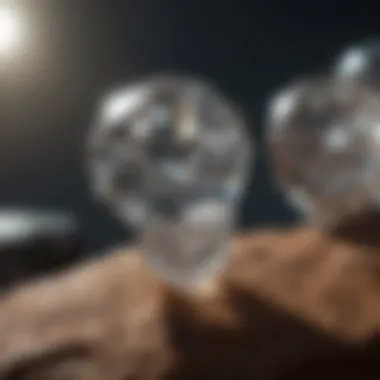
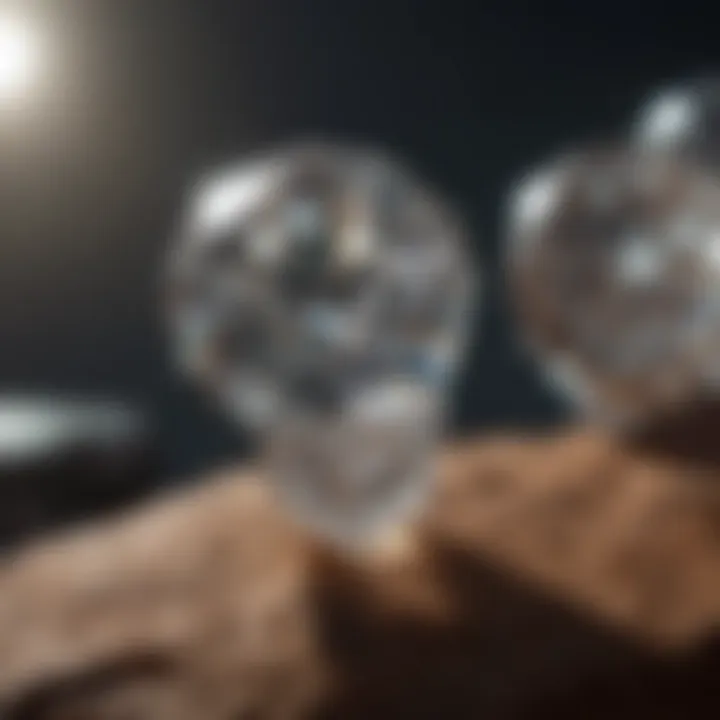
Natural Diamond Formation
Natural diamonds form through geological processes over millions of years. This section provides insight into the environmental factors and time required for their formation.
Geological Conditions
When discussing geological conditions, we refer to the extreme environments in which natural diamonds form. Typically, natural diamonds emerge in the Earth’s mantle under conditions featuring high pressure and temperature. This specific type of formation occurs around 150 to 200 kilometers deep in the Earth, often in regions known as cratons, which have remained stable for long periods of geological time.
A key characteristic of these geological conditions is the uniqueness of each diamond's environment. The slow crystallization process allows for complex crystal structures and imperfections that contribute to a diamond’s unique identity. This natural setting is often seen as beneficial because it adds an element of story to each diamond, resonating with consumers who value authenticity and rarity. However, it also presents disadvantages, like the high energy and resource costs associated with mining.
Time Frame for Formation
The time frame for formation is another important aspect to consider. Natural diamonds can take anywhere from 1 billion to 3.3 billion years to form. This prolonged process adds to the mystique surrounding them, as most attributions link such a significant time span to enduring qualities. The lengthy timeline plays a pivotal role in a diamond's cultural and historical significance.
A primary benefit of this extensive time frame is that it imparts a sense of history to natural diamonds, making them sought after in heirlooms and collections. However, the extensive timeframe also brings with it a considerable amount of risk and uncertainty, from geological events that can disrupt formation to market factors severely affecting perceptions.
Lab-Created Diamond Techniques
In contrast to their natural counterparts, lab-created diamonds undergo a different set of processes that condense the extensive time frame and geological variability into a controlled environment. Exploring these manufacturing techniques is vital for understanding how lab-created diamonds measure up against natural ones.
High-Pressure High-Temperature (HPHT)
The High-Pressure High-Temperature method replicates the natural process of diamond formation. In this technique, carbon is subjected to extreme pressures and temperatures that mimic the conditions found deep within the Earth. This method allows for the creation of diamonds in a fraction of the time it would take naturally—often just weeks.
A notable characteristic of HPHT diamonds is that they can exhibit remarkably similar physical properties to natural diamonds. This makes them an attractive option for consumers seeking beauty and durability at a fraction of the price. However, this method can sometimes lead to diamonds with distinct characteristics that can be identified by experts, such as growth lines or metallic inclusions, which some collectors may view as drawbacks.
Chemical Vapor Deposition ()
On the other hand, the Chemical Vapor Deposition method involves using carbon-rich gases to deposit carbon atoms onto a substrate, creating diamonds from the ground up. This process is not only faster but also allows for various adjustments to be made, offering a wider range of colors and qualities than natural counterparts.
CVD diamonds are often considered advantageous because they can be produced sustainably and can avoid many of the ethical dilemmas associated with traditional mining practices. However, this approach also raises questions about authenticity and inherent value, as some consumers may feel that lab-created varieties lack the "soul" of their natural counterparts.
In summary, the way diamonds are formed—whether through natural geological processes or innovative lab techniques—provides insight into their respective qualities and market positioning. These differences are invaluable for those navigating the landscape of modern gemstones, offering clarity in a sometimes murky world.
Physical and Chemical Properties
Understanding the physical and chemical properties of diamonds is essential for anyone in search of comprehensive knowledge on this precious stone. These attributes not only shape their appearance but also establish their value and utility in various applications. The distinctions between lab-created and natural diamonds reveal a wealth of insights into how diamonds are perceived in both identity and marketability.
Comparing Hardness and Brilliance
Diamonds are renowned for their unmatched hardness, rated 10 on the Mohs scale. This attribute makes them exceptionally durable, which is a significant factor for jewelry wearers. Both lab-created and natural diamonds exhibit this hardness; however, the brilliance—or how light interacts with the stone—can vary slightly based on their growth environment.
In natural diamonds, the presence of inclusions can scatter light, affecting brilliance. Lab-created diamonds can be produced in conditions that minimize these imperfections, potentially resulting in stones that reflect light more efficiently. Yet, there isn’t a clear winner; both types can dazzle, but subtle differences in brilliance might cause some to prefer one type over the other. Different cutting styles also play a role here:
- Round cut diamonds often maximize brilliance.
- Cushion cut diamonds provide a softer, more romantic glow.
Thus, while hardness remains constant, perceptions of brilliance can lead to varied preferences among buyers.
Inclusions and Flaws
The presence of inclusions or flaws is like a fingerprint; no two diamonds are completely alike. Inclusions are internal characteristics, while flaws can occur on the surface. Their existence plays a crucial role in determining the clarity rating, which directly impacts value.
Natural diamonds typically contain natural inclusions formed during their lengthy geological journey. In contrast, lab-created diamonds often have inclusions from the growth process, which enthusiasts may regard as indications of authenticity or craftsmanship. Some common types of inclusions include:
- Feathers: Tiny cracks that resemble feathers, often present in natural diamonds.
- Pinpoints: Tiny, reflective spots that can occur in both types.
Gemologists use these characteristics to discern authenticity, but it's worth noting that inclusions don't always denote lesser quality. For some, they add to the story of the stone rather than detract from it.
Color and Clarity Grading
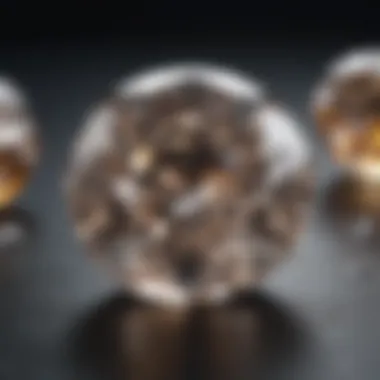
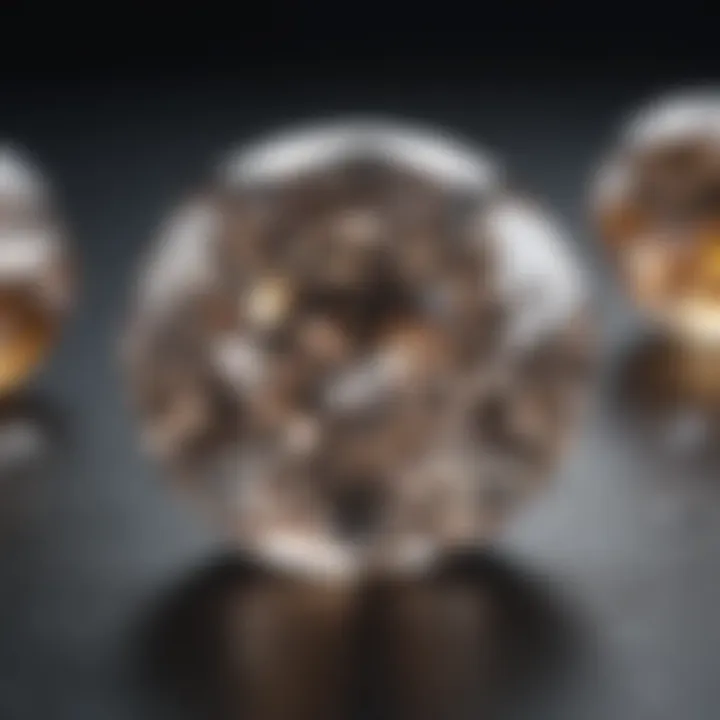
Color and clarity grading systems heavily influence the market perception of diamonds. Natural diamonds come in a variety of colors, ranging from the rare blue Argyle diamonds to the more common yellow varieties. The grading system, established by the Gemological Institute of America, organizes diamonds from D (colorless) to Z (light yellow or brown).
Lab-created diamonds can also display a spectrum of colors, with the ability to produce near-colorless stones with fewer inconsistencies than their natural counterparts. This ability can appeal to consumers who prioritize clear stones for their engagement rings or special occasion jewelry.
When examining clarity, natural and lab-created diamonds are graded similarly. Yet, some find that lab-created stones often achieve higher clarity grades with fewer inclusions or blemishes. This is particularly advantageous for buyers who desire a pristine appearance.
"When it comes to choosing between lab-created and natural diamonds, understanding properties like color and clarity can make the decision clearer—forgive the pun!"
In summary, the physical and chemical properties shape not only the aesthetic beauty of diamonds but also their perceived value in the marketplace. Whether one opts for lab-created or natural diamonds may very well hinge on personal preference influenced by these detailed attributes.
Identification Techniques
Understanding how to differentiate between lab-created and natural diamonds is not just an academic exercise. It’s essential for those who are making informed choices in purchases whether for investment, personal adornment, or collections. Identification techniques can significantly influence the perceived value and authenticity of gemstones in the market. In this section, we dive deep into the methods available for distinguishing between these two categories of diamonds.
Gemological Identification Methods
Gemologists employ various methods to identify and categorize diamonds. Traditional gemological practices largely depend on observable characteristics through visual inspection and basic tools. Some of the key aspects include:
- Microscopic Inspection: Experts use tools such as microscopes to observe inclusions and growth patterns. Natural diamonds often have unique irregularities called inclusions, while lab-created ones might appear more uniform.
- Refractive Index Test: Diamonds have a specific refractive index. By shining a light into the stone and measuring how it refracts, gemologists can identify inconsistencies that can indicate creation environment.
- UV Light Inspection: Under ultraviolet light, natural diamonds can exhibit fluorescence differently than lab-created ones. This ambient light illumination helps in distinguishing the two types based on their behavior under UV rays.
Each of these methods highlights how trained professionals can read the story behind each gemstone, much like a detective reading clues at a crime scene. Moreover, subtle differences in response to these tests can make all the difference in correctness of identification.
Advanced Technological Tools
In today’s fast-paced world, technology has not been left behind in the endeavor to identify diamonds with an elevated level of accuracy. The development of advanced identification techniques has allowed for a more sophisticated approach to distinguishing diamonds.
- Fourier Transform Infrared Spectroscopy (FTIR): This method analyzes the absorption of infrared light by the diamond, revealing its chemical structure. Lab-created diamonds typically have different spectroscopic signatures compared to natural ones.
- Raman Spectroscopy: Using a laser to analyze the molecular composition, this technique helps detect specific features that point to the stone's origin. The patterns help in demystifying which diamonds were formed in the Earth's mantle versus those created in a lab.
- Photoluminescence: This technique involves exciting the diamond with a light source to observe the outlined colors emitted. It can provide insights into whether a diamond bears natural or synthetic characteristics.
Such technological tools elevate the precision of identification, allowing professionals to achieve almost impeccable accuracy. As the market grows, these technologies continue developing, reflecting both the man-made and natural aspects of diamond creation.
The integration of advanced gemological practices can significantly affect market value, underscoring the importance of proper identification in safeguarding investments.
Ultimately, whether through traditional gemological methods or modern technological tools, understanding how to effectively identify diamonds remains critical. For enthusiasts, collectors, and jewelers alike, mastering these techniques signals an investment in knowledge that protects both monetary and sentimental values.
Ethical Considerations
When it comes to diamonds, the ethical implications of their origins carry heavy weight. Ethical considerations focus on understanding how diamonds are sourced, produced, and their impact on society and the environment. Differentiating between lab-created and natural diamonds opens a conversation about responsibility in the industry and consumer choices. This section aims to shed light on the importance of these ethical concerns, ensuring that consumers are not just informed but also conscientious in their jewelry purchases.
Conflict Diamonds vs. Lab-Created Options
Conflict diamonds, often referred to as "blood diamonds," are mined in war zones and sold to fund armed conflict. The sale of these stones has had devastating effects on communities, leading to violence, exploitation, and severe human rights abuses. This historical narrative has cast a long shadow over the diamond industry, making it crucial for buyers to know the origins of the stones they purchase.
- Key Points on Conflict Diamonds:
- Often mined under dangerous conditions.
- Associated with significant human suffering and environmental degradation.
On the other hand, lab-created diamonds provide a clear contrast. Produced with advanced technology in controlled environments, these diamonds do not contribute to conflict or social turmoil. Moreover, with growing awareness around ethical sourcing, many consumers prefer lab-created options. They represent not only a commitment to ethical practices but also an exciting alternative that possesses the same physical and chemical properties as natural diamonds.
"Choosing lab-created diamonds allows consumers to feel good about their purchase, knowing they are not complicit in funding violence or exploitation."
Sustainability Factors
In this age of climate consciousness, sustainability looms large on the horizon of modern consumer choices. The environmental footprint of traditional diamond mining is staggering, from habitat destruction to water consumption. Often, natural diamond extraction involves considerable ecological disruption, leading to long-lasting damage in many regions.
Conversely, lab-created diamonds emerge as a more sustainable option. Their production typically requires fewer natural resources and has a significantly reduced impact on the environment. A commitment to sustainability in the jewelry industry must consider aspects such as:
- Energy consumption in production processes.
- Waste management practices during creation.
- Life cycle analysis of diamonds, from the lab to the consumer.
By opting for lab-created diamonds, consumers align their purchasing power with values that prioritize sustainability. As more individuals recognize the importance of ethical considerations in their choices, the demand for lab-created options will likely continue to rise. In turn, this shift could inspire further advancements in sustainable practices within the broader gemstone industry.
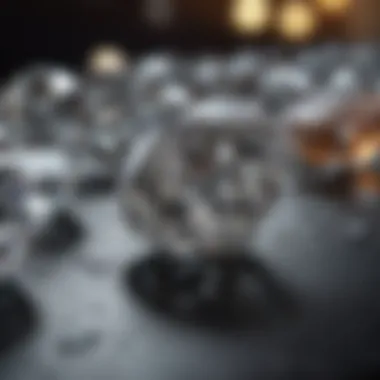
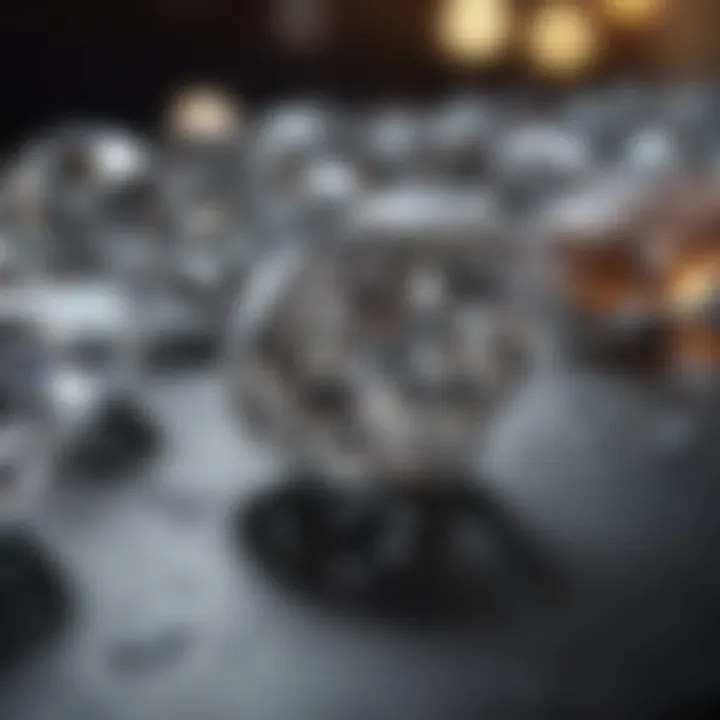
The Market Perspective
In the world of diamonds, the shifting sands of consumer demand and economic dynamics have unleashed a variety of perspectives regarding the value and appeal of lab-created versus natural diamonds. Understanding this marketplace is essential for anyone contemplating a purchase, whether they are gem enthusiasts, collectors, or jewelry designers. The market for diamonds was traditionally dominated by natural stones, steeped in history and perceived value, but the emergence of lab-created diamonds has changed the narrative profoundly. This evolution prompts a closer look at specific elements such as price differences and consumer preferences.
Price Differences between Lab-Created and Natural Diamonds
When it comes to pricing, lab-created diamonds generally present themselves as a more affordable option compared to their natural counterparts. This disparity can be attributed to various factors:
- Production Costs: Natural diamonds are mined from the earth and require extensive resources, labor, and time. Conversely, lab-created diamonds are produced through advanced technology, often culminating in less expensive operational costs.
- Market Saturation: The availability of lab-created diamonds is steadily increasing, leading to a more competitive market. This heightened availability often drives prices lower.
- Resale Value: Although natural diamonds often boast higher appreciation over time due to their rarity, lab-created diamonds might not hold the same resale value. Consumers should consider this aspect when weighing their options.
Prices of lab-created diamonds can typically be 20% to 40% lower than those of natural diamonds, which can be a significant saving for many buyers. In this context, buyers are making economic decisions, balancing between initial costs and long-term value retention.
Market Trends and Consumer Preferences
The marketplace is not just a realm of numbers. It reflects societal attitudes and changing values. As consumers become more conscious about ethical sourcing and environmental impact, trends are shifting significantly:
- Ethical Considerations: Lab-created diamonds offer a transparent method of sourcing, often appealing to those who are wary of conflict diamonds and the environmental toll of mining. Consumers are increasingly embracing these ethical implications as part of their purchasing decisions.
- Changing Perceptions: Initially viewed as inferior, lab-created diamonds are now gaining recognition for their beauty and quality, leading to a growing acceptance among the public. This shift underlines the fluid nature of market perception based on evolving values.
- Target Demographics: Younger generations, particularly millennials and Gen Z, seem more inclined to choose lab-created options. They often prioritize sustainability and ethical origins, leading to a notable demographic shift.
"In the diamond market, sentiment can change as fast as a swift summer breeze, shaping buying habits and altering demand."
As we delve deeper into the landscape of the diamond market, recognizing these trends will aid enthusiasts in making informed choices. Ultimately, whether one leans towards the allure of natural diamonds or the modern appeal of lab-created variants, a solid grasp of market perspectives will illuminate the path forward.
Cultural and Historical Context
Understanding the cultural and historical context surrounding diamonds is critical in grasping how both natural and lab-created diamonds fit into our society today. Diamonds have long been staunch symbols of beauty, wealth, and power. Their allure stems not just from their stunning physical characteristics, but also from the tales woven around them throughout history. This section delves into the significance of these stones in various cultures and the gradual acceptance of lab-created counterparts.
Historical Significance of Natural Diamonds
Natural diamonds have been adoring human society for centuries, first discovered in ancient India, where they were revered not only for their beauty but also for their supposed mystical properties. Historians suggest that by the 4th century BCE, diamonds were already making their way into royal treasuries and adornments. As they spread from India to Europe via trade routes, they became synonymous with wealth and status.
When we talk about their historical significance, we have to consider a few points:
- Cultural Symbolism: In many cultures, diamonds represented eternal love and commitment, becoming a cornerstone of engagement traditions. The age-old saying, "Diamonds are forever," speaks to this sentiment, making them a must-have in matrimonial customs.
- Economic Impacts: Natural diamonds have had profound economic consequences through the ages. The diamond trade once fueled economies, shaping geopolitical landscapes across continents. The discovery of diamond mines in South Africa transformed its economy and colonial practices, causing significant changes in social structures.
- Artistic Inspirations: Renowned artists, poets, and writers have often used diamonds as metaphors in their work. From Shakespeare referencing them as symbols of perfection to modern music praising their brilliance, they reflect societal values and aspirations.
Emergence of Lab-Created Diamonds in Society
As technology advanced, the way we perceived diamonds began to shift. Lab-created diamonds have emerged as viable alternatives to their natural counterparts, challenging long-held beliefs about authenticity and value.
Key aspects defining their rise in society include:
- Technological Advancements: Techniques like High-Pressure, High-Temperature and Chemical Vapor Deposition have made it feasible to create diamonds in laboratory settings. This innovation has not only made diamonds more accessible but has also ignited discussions on their legitimacy as gemstones.
- Changing Consumer Attitudes: In a world increasingly aware of ethical and environmental issues, lab-created diamonds have captured the interest of socially-conscious consumers. Buying such diamonds appeals to those who wish to avoid contributions to conflict or environmental degradation caused by mining.
- Cultural Shifts: The modern narrative around lab-created diamonds increasingly celebrates individuality. Many contemporary consumers view these stones as symbols of innovation rather than mere substitutes, marking a notable departure from traditional perspectives.
"Lab-created diamonds exhibit the same optical and physical properties as natural ones, challenging our perceptions of what it means to be genuine."
In summary, recognizing the cultural and historical context of diamonds provides valuable insights into their evolving significance. With a better understanding of how these stones are perceived through time, enthusiasts, collectors, and designers can navigate the intricate landscape of both natural and lab-created diamonds more thoughtfully. As society continues to evolve, so too does our relationship with these exquisite gems.
The End
The conclusion serves as a pivotal point in understanding the broader implications of lab-created and natural diamonds, especially in a world where choices about luxury items increasingly hinge on factors like ethics and sustainability. Through a deep dive into the differences and similarities covered in the previous sections, readers can grasp the full picture of what each diamond type offers.
Making an Informed Choice
When it comes to making an informed choice about purchasing diamonds, well, the decision is often more layered than it appears at first glance. Consider some key factors:
- Purpose of the Purchase: Are you buying for an engagement, a gift, or investment? Each scenario may call for a different option.
- Value Perception: Natural diamonds carry a historic charm, while lab-created diamonds offer a contemporary twist that's hard to ignore. The emotional significance you attach to each can heavily influence your decision.
- Budget Constraints: Often, lab-created diamonds are priced more accessibly compared to their natural counterparts. This can allow buyers to maximize their investment without skimping on quality.
In summary, it’s essential to evaluate your lifestyle and values against what each diamond type represents. Knowing the details—from their formation processes to their market dynamics—helps you navigate this unique journey.
The Future of Diamonds in the Gemstone Industry
The landscape of the diamond industry is shifting. As conversations around sustainability and ethical consumption gain momentum, the future looks brighter for lab-created diamonds. Here are a few trends that stand out:
- Innovation in Technology: With advancements in growth techniques, the quality and appeal of lab-created diamonds continue to rise, making them a strong contender in the market.
- Changing Consumer Preferences: A growing number of consumers are actively seeking out ethical options over traditional diamonds. This trend speaks volumes about shifting priorities as we become more conscientious buyers.
- Market Predictions: Economic forecasts suggest that lab-created diamonds will not only gain market share but may also redefine luxury standards altogether. With their lower environmental impact and fair pricing, they offer a compelling alternative that aligns with an eco-conscious worldview.
As the industry evolves, both gemstone enthusiasts and casual buyers are presented with an expanding array of choices. Each option, whether lab-created or natural, holds its significance, and understanding their underlying nuances is essential. Knowledge is your best ally in this shimmering world of diamonds.



